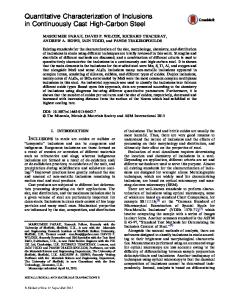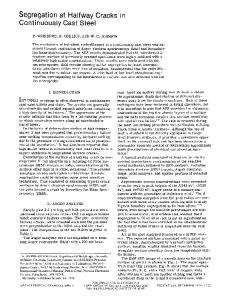Some effects of electromagnetically induced fluid flow on macrosegregation in continuously cast steel
- PDF / 2,097,208 Bytes
- 9 Pages / 603 x 783 pts Page_size
- 85 Downloads / 291 Views
P A S T r e s e a r c h has shown that the solidification structure of s t e e l has a significant effect upon the properties of the final products .1-4 This effect is even more intense in continuous casting than in ingot casting because of the intensely anisotropic solidification structure usually found in continuously cast products. The solidification structure in continuously cast steels can be controlled by electromagnetic s t i r r i n g of the liquid m e t a l pool.5,6 Induction s t i r r i n g in continuous casting causes a sweeping flow a l o n g the solid-liquid interface which removes most of the "mushy z o n e " and affects the final solidification structure. Some investigators have found, however, that intense stirring can s o m e t i m e s r e s u l t in localized segregation in cast metals.7,s Therefore, an understanding of the effects of controlled fluid flow on macrosegregation in continuous casting is of g r e a t importance. The p u r p o s e of this investigation, parts of which are reported h e r e , was to study the effects of controlled fluid flow during solidification on localized segregation and centerline homogeneity within continuously cast steel. Measurements of segregation have been performed on both s t i r r e d and nonstirred 8 - 3 / 4 in. x 10 in. (222 mm x 254 mm) continuously cast low-alloy s t e e l billets in the "as c a s t " condition and on r o l l e d products from these billets. I.
LITERATURE-THEORY
One of the metallurgical problems found in continuously cast products is the development of l a r g e columnar dendritic zones. The effect of columnar growth on the mechanical properties such as loss of ductility in s t e e l has been investigated by Weiser. 9 Alberney, et a l 1° have shown that centerline defects in continuous casting can be significantly reduced by controlling the columnar growth regions. Japanese investigators have also attempted to control columnar growth in continuous castings. H Our res e a r c h work on induction s t i r r i n g and segregation D. J. HURTUK is Research Engineer, Republic Steel Corporation, Research Center, Independence, OH44131, and A. A. TZAVARAS, formerly withRepublicSteel Corporation, is now Professor of Metallurgy, Aristotelian University, Greece. Manuscript submitted June 2, 1976. METALLURGICAL TRANSACTIONS B
has indicated that the control of columnar growth is crucial in producing good quality strand cast products .12 Essentially, induction s t i r r i n g causes a sweeping flow along the solid-liquid interface which affects the final solidification structure because it influences the l o c a l growth conditions such as the temperature gradient, the boundary l a y e r thickness, and the structure and size of the "mushy zone".s Since macrosegregation is known to r e s u l t from interdendritic fluid flow, reduction in the length of the "mushy z o n e " should effectively reduce the extent of m a c r o s e g r e gation, particularly along the centerline. 13 Wojcik14 has reported that electromagnetic stirring reduced macrosegregation
Data Loading...











